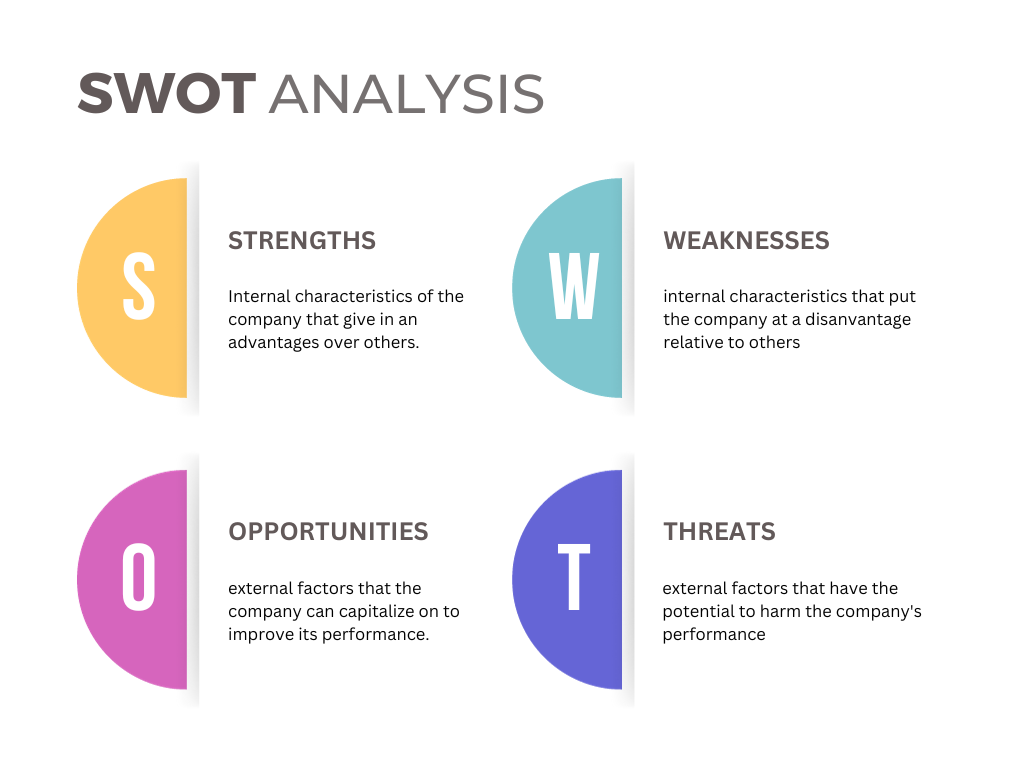In a world where strategic planning is pivotal for success, SWOT Analysis stands as a cornerstone tool, guiding businesses and individuals alike toward their goals. SWOT, an acronym for Strengths, Weaknesses, Opportunities, and Threats, is a structured planning method used to evaluate these four elements within a project or business venture. This article aims to provide a comprehensive guide on conducting a SWOT Analysis, highlighting its significance, steps, and best practices.
The Essence of a SWOT Analysis
A SWOT Analysis is more than just a tool; it’s a lens through which one can view and assess the internal and external factors that impact success. Its simplicity and versatility make it applicable across various industries and personal endeavors. By dissecting these four elements, a SWOT Analysis offers a balanced perspective on where one stands, what challenges lie ahead, and where the potential for growth exists.
Whether you’re spearheading a new business initiative, charting a career path, or steering an established organization, a SWOT Analysis can illuminate the path forward. It provides a framework to harness your strengths, address your weaknesses, seize opportunities, and mitigate threats, ensuring informed decision-making and strategic planning.
The power of SWOT Analysis lies in its simplicity and depth. Each component – Strengths, Weaknesses, Opportunities, and Threats – plays a crucial role in painting a complete picture of the situation at hand.
Strengths: Your Competitive Edge
Strengths are the favorable traits, skills, or assets that an individual or organization possesses. These can range from a strong brand reputation, a loyal customer base, and proprietary technology, to personal skills and networks. Identifying these strengths helps in leveraging them effectively to achieve goals and stand out in the competitive landscape.
Weaknesses: Areas for Improvement
Weaknesses are internal factors that may hinder or obstruct your objectives. These could be limited resources, gaps in expertise, or operational inefficiencies in a business context. For individuals, weaknesses might include a lack of experience in certain areas or unrefined skills. Acknowledging and addressing these weaknesses is key to creating robust strategies.
Opportunities: Prospects for Growth
Opportunities are external factors that can be capitalized upon. They represent the potential for growth and success. In the business world, opportunities can manifest as untapped markets, emerging trends, or favorable regulatory changes. For individuals, it could be an emerging need in their field of expertise or a networking opportunity that could open new doors.
Threats: Potential Challenges
Threats include external factors that could adversely affect your goals. These might be competitive pressures, changing market dynamics, or technological advancements that disrupt existing processes. Recognizing these threats is vital for developing strategies to mitigate or circumvent potential risks.
Preparing for a SWOT Analysis
Embarking on a SWOT Analysis requires preparation and a structured approach to ensure its effectiveness and accuracy.
Setting Clear Objectives
The first step in a SWOT Analysis is to define clear, specific objectives. What do you want to achieve with this analysis? Are you assessing the viability of a new project, looking to improve your business strategy, or evaluating your career path? Clear objectives set the stage for a focused analysis.
Assembling the Right Team
In a business context, assembling a team with diverse perspectives is crucial. Include individuals from various departments, marketing, finance, operations, to get a holistic view. For personal SWOT Analysis, seeking input from mentors, peers, and colleagues can offer valuable insights.
Gathering Necessary Tools and Resources
Prepare the necessary tools for the analysis. This might include data reports, market research, and a whiteboard or digital tool for creating the SWOT matrix. Having all relevant information at hand will facilitate a more comprehensive and accurate analysis.
Identifying Strengths
The identification of strengths is a critical component of SWOT Analysis. It involves introspection and analysis to pinpoint the unique advantages one holds.
Recognizing and Leveraging Internal Advantages
- Begin by listing the internal attributes that give you or your organization an edge. Consider what you do well, what unique resources you possess, and what others see as your strengths. This could include operational excellence, a skilled workforce, or a strong financial position.
- Once identified, the focus shifts to leveraging these strengths. How can these advantages be used to achieve your objectives? In what ways can these strengths help to capitalize on opportunities or counteract potential threats?
A common pitfall in identifying strengths is complacency. It’s important to not just acknowledge existing strengths but also to continuously develop and nurture them to maintain a competitive edge.
Assessing Weaknesses
An honest assessment of weaknesses is as important as recognizing strengths. It’s about understanding the areas where improvement is needed to achieve your goals.
Identifying Weak Areas and Strategies for Addressing Weaknesses
- This step involves identifying the areas where you or your organization fall short. It could be resource constraints, lack of specific skills, or operational inefficiencies. For individuals, it might involve skills that need development or personal traits that limit progress.
- Once weaknesses are identified, developing strategies to address them is crucial. This might involve training and development, process improvements, or strategic partnerships. For personal development, it could mean seeking mentorship, additional training, or adjusting one’s approach.
Recognizing weaknesses can be challenging, as it requires admitting vulnerabilities. However, this acknowledgment is essential for growth and development. It’s about turning perceived negatives into opportunities for improvement.
Exploring Opportunities
The exploration of opportunities is a dynamic and forward-looking aspect of a SWOT Analysis. It’s about recognizing and seizing the external factors that can propel you toward success.
Identifying External Chances for Growth and Evaluating and Seizing Opportunities
- Opportunities often arise from changes in the market, technological advancements, policy shifts, or societal trends. In a business context, it could be an emerging market demand, a gap in competitors’ offerings, or new technological innovations. For individuals, opportunities might present themselves as new career paths, educational programs, or networking events.
- The key is not just to identify opportunities but to evaluate their potential impact and feasibility. Ask questions like: How does this opportunity align with my strengths? What resources are needed to seize it? This evaluation guides you in prioritizing opportunities and developing strategies to capitalize on them.
One common mistake is failing to recognize or act upon opportunities due to a lack of awareness or fear of taking risks. Staying informed, open-minded, and ready to step out of your comfort zone is critical in taking full advantage of potential opportunities.
Analyzing Threats
Analyzing threats is about understanding and preparing for external factors that could negatively impact your objectives. This proactive approach is crucial for risk mitigation and strategic planning.
Recognizing External Dangers and Developing Strategies for Mitigating Threats
- Threats can come from various sources: competitive pressures, market changes, regulatory developments, or technological disruptions. For individuals, threats might include shifts in industry demands or job market trends. Identifying these threats requires staying informed about your environment and being aware of potential changes that could impact you.
- Once identified, developing strategies to mitigate these threats is essential. This might involve diversifying your product line, investing in new technologies, or enhancing your skill set. The goal is to minimize the impact of these threats or to turn them into opportunities.
A common oversight is underestimating or ignoring potential threats, either due to complacency or overconfidence in one’s strengths. This can lead to unpreparedness and significant setbacks. Acknowledging and planning for threats is crucial for long-term stability and success.
Constructing the SWOT Matrix
The SWOT Matrix is a visual representation that helps organize and summarize the findings of your SWOT Analysis. This tool aids in the strategic planning process, providing a clear overview of where you stand.
The matrix is divided into four quadrants, each representing one element of SWOT: Strengths (top left), Weaknesses (top right), Opportunities (bottom left), and Threats (bottom right). This layout helps in comparing and contrasting these elements.

In each quadrant, list the specific elements identified in your analysis. Be concise and prioritize the most significant points. The matrix should be a clear, easy-to-understand summary of your internal and external analysis.
Here’s a good, simple SWOT Analysis template from Smartsheet.
The completed matrix serves as a foundation for strategy development. It helps in identifying the relationships between different elements. For instance, how can you use your strengths to exploit opportunities or mitigate threats? How can you overcome your weaknesses to avoid threats or seize opportunities?
Interpreting SWOT Analysis Results
Interpreting the results of a SWOT Analysis involves synthesizing the information into actionable strategies. This step is critical in translating the analysis into practical steps towards achieving your objectives.
A key part of interpretation is understanding how the different elements of SWOT interact with each other. This involves looking for ways to use your strengths to capitalize on opportunities and mitigate threats, as well as improving weaknesses that may hinder progress.
Formulating Strategies
Based on the interconnections identified, develop strategies that play to your strengths, improve your weaknesses, seize your opportunities, and mitigate your threats. These strategies should be SMART (specific, measurable, achievable, relevant, and time-bound). And of course, they should be aligned with your overall objectives.
Implementing and Reviewing the Strategies
After formulating the strategies, the next step is implementation. Set actionable goals and timelines for each strategy. Regularly review and adjust these strategies in response to changes in the internal and external environment. This ongoing process ensures that your approach remains relevant and effective. This is absolutely critical for achieving results.
Best Practices and Common Mistakes
To effectively utilize a SWOT Analysis, it’s essential to adhere to best practices while avoiding common pitfalls.
Best Practices for Effective Analysis
- Objectivity: Approach the analysis with an unbiased perspective, relying on factual data rather than assumptions.
- Comprehensiveness: Be thorough in exploring each element of SWOT, considering all possible factors.
- Inclusivity: Include diverse perspectives, especially in a team setting, to ensure a well-rounded analysis.
Common Mistakes to Avoid
- Overgeneralization: Avoid vague or broad statements. Specificity leads to more actionable insights.
- Ignoring External Factors: Failing to adequately consider opportunities and threats can leave you unprepared for market changes.
- Static Analysis: SWOT Analysis should be an ongoing process, adapting to new information and changing circumstances.
Advanced Techniques in a SWOT Analysis
Enhancing your SWOT Analysis with advanced techniques can provide deeper insights and more strategic value.
Integration with Other Strategic Tools
- PESTEL Analysis: Combine SWOT with PESTEL (Political, Economic, Social, Technological, Environmental, Legal) to deepen your understanding of external factors.
- Porter’s Five Forces: Use this framework to assess competitive forces and market dynamics, complementing your SWOT Analysis.
Quantitative SWOT Analysis
Introducing quantitative elements, like scoring each factor based on impact and likelihood, can add precision to your analysis, helping prioritize focus areas. For example, you can weight each item on a scale of 1 to 5 to help you focus your resources accordingly.
Conclusion
A SWOT Analysis is a powerful tool that offers comprehensive insights for strategic planning. Its simplicity and adaptability make it applicable across various contexts, from business strategies to personal development.
The effectiveness of SWOT Analysis lies in its implementation. It’s not just about identifying strengths, weaknesses, opportunities, and threats, but about turning these insights into actionable strategies. Regular reviews and updates are essential to maintain relevance and effectiveness.
Whether you’re a business leader, a professional, or an individual looking to grow, a SWOT Analysis can provide valuable insights. By embracing SWOT Analysis as a regular part of your strategic planning, you can enhance decision-making, uncover new opportunities, and navigate challenges with greater confidence and clarity.


